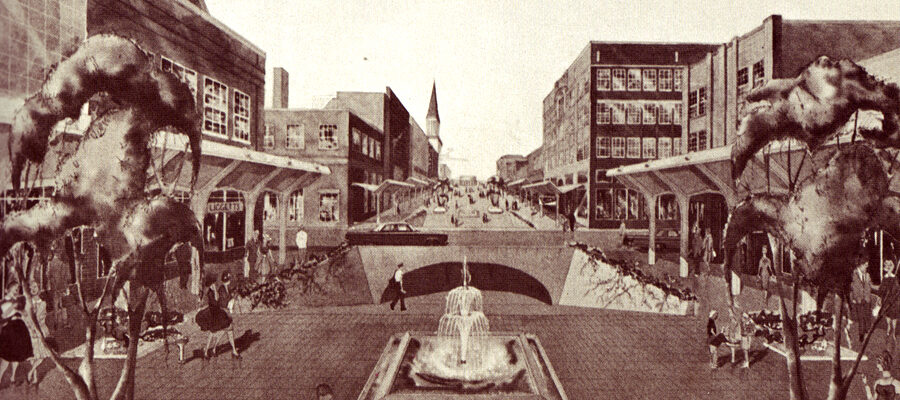A 28-page city progress report addressed to the people of Johnson City from the Mayor and Board of Commissioners was issued in 1965. D.A. Burkhalter, then City Manager, produced the booklet for the citizens of Johnson City to inform them of community progress that had been made over the previous two years.
The front cover contained a circular symbol of progress with “1869” inside it, denoting the year the city was incorporated. In addition to Burkhalter, the commissioners included Ross Spears, Jr. (Mayor); Edward N. Backus (Vice Mayor); Mrs. May Ross McDowell, Hal Littleford, Robert E. Henry and Jack B. Strickland (Assistant City Manager).
The booklet was divided into seven sections: “People Progressing, People Providing, People Participating, People Planning, People Preparing, People Playing and People Protecting.”

The most amazing and eye-catching item in the report was an artist’s rendering of a futuristic Main Street. The photo was taken from about midway on E. Main Street facing east. Main Street is permanently closed to vehicular traffic from Fountain Square to what appears to be Colonial Drive or possibly Division Street. Shoppers do not have to cross Roan Street to access stores on the east side of town; instead, they walk through an underground pedestrian tunnel under Roan Street. Flowers, trees and benches line both sides of the street with a large fountain (not the Lady of the Fountain) in the middle of the block near S.H. Kress. Unfortunately, this grandiose farsighted and obviously expensive vision never materialized.
A glance back at the city’s impressive accomplishments for 1963 included a Pro Shop and 9-hole Municipal Golf Course; new fire station in North Johnson City; new fire pumper; 764 new street lights; four new classrooms to Fairmont Elementary School; modernization of City Garage facilities; Management Program for the city’s 1500 acres of water-shed land; completed survey of leaks in the city’s water system, saving of hundreds of thousands of gallons daily; the first Tennessee city to participate in the People-to-People program, choosing Guaranda, Ecuador as its “Sister City”; a litter ordinance and installation of numerous receptacles in downtown Johnson City; an Advisory Committee for Human Relations; new sanitary landfill site purchased; improvements at Civitan, Rotary, Kiwanis and Carver Parks; major improvements at Lions, Jaycees, Towne Acres and Civitan Parks; systematic replacement of city street name signs with attractive reflectorized ones; comprehensive Neighborhood Improvement Program; report on area-wide vocational-technical training school for Upper East Tennessee; revised city zoning ordinance and map after detailed study; the most comprehensive street improvements program in the city’s history at a cost of a quarter million dollars; and commencement of the initial phase of Downtown Improvement Program.
Some of the 1964 accomplishments 1964 included adoption of an official city flag; inaugurated Youth-in-Government Day; approved additional downtown parking lot; welcomed 75 Latin-American Mayors and other officials to the city; improved traffic circulation at intersections; and moved the sanitary landfield.
The report concluded with seven future plans for the city: Provide additional water sources; revitalize the downtown area; construct a new municipal and public safety building; continue to extend sewers; build additional school facilities; improve the street system; and expand recreational programs and facilities.

Comments are closed.